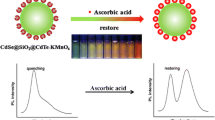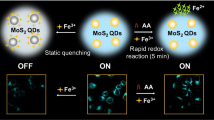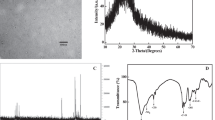Abstract
An AND-NAND logic pair is reported based on non-purified carbon quantum dots (CDs) for ascorbic acid (AA) detection. In the logic operation, molybdenum oxide nanosheets (MoO3 NSs) and AA are used as two signal inputs. In the presence of AA, MoO3 NSs are reduced to plasmonic molybdenum oxide, which decreases the CD fluorescence intensity because of a static quenching, dynamic quenching, and internal filtration effect. Meanwhile, the AA is oxidized to dehydroascorbic acid and forms fluorescent 3-(dihydroxyethyl) furo [3,4-b] quinoxaline-1-one with o-phenylenediamine from non-purified CDs. On this basis, an AND-NAND logic pair was constructed and used as a ratiometric fluorescence sensor for highly sensitive detection of AA. The method has a wide linear range of 0.05–50 μM, and a detection limit of 34 nM. In addition, it was used to detect AA in fresh fruit. Potential applications include chemical computing, optoelectronic devices, biomedical science, and environmental monitoring.
Highlights
1. A ratiometric fluorescence sensor based on AND-NAND logic pair constructed by CDs and MoO3 NSs was successfully fabricated.
2. The ratiometric fluorescence sensor exhibited satisfactory linear range, high sensitivity, and good selectivity for AA.
3. The ratiometric fluorescence method was able to detect AA in fresh fruit with good results comparable to official fluorescence methods.
Graphical abstract






Similar content being viewed by others
References
Margulies D, Melman G, Shanzer A (2005) Fluorescein as a model molecular calculator with reset capability. Nat Mater 4(10):768–771
Huang W, Zhou Y, Du J, Deng Y, He Y (2018) Versatile visual logic operations based on plasmonic switching in label-free molybdenum oxide nanomaterials. Anal Chem 90(3):2384–2388
Bonnet J, Yin P, Ortiz ME et al (2013) Amplifying genetic logic gates. Science 340(6132):599–603
Jiang XJ, Ng DK (2014) Sequential logic operations with a molecular keypad lock with four inputs and dual fluorescence outputs. Angew Chem Int Edit 53(39):10481–10484
Liu D, Chen W, Sun K et al (2011) Resettable, multi-readout logic gates based on controllably reversible aggregation of gold nanoparticles. Angew Chem Int Edit 50(18):4103–4107
Zhang Y, Shuai Z, Zhou H et al (2018) Single-molecule analysis of microRNA and logic operations using a smart plasmonic nanobiosensor. J Am Chem Soc 140(11):3988–3993
Hettie KS, Klockow JL, Glass TE (2014) Three-input logic gates with potential applications for neuronal imaging. J Am Chem Soc 136(13):4877–4880
Badeau BA, Comerford MP, Arakawa CK et al (2018) Engineered modular biomaterial logic gates for environmentally triggered therapeutic delivery. Nat Chem 10(3):251–258
Yan C, Guo Z, Liu Y et al (2018) A sequence-activated AND logic dual-channel fluorescent probe for tracking programmable drug release. Chem Sci 9(29):6176–6182
Fan D, Wang E, Dong S (2017) An intelligent universal system yields double results with half the effort for engineering a DNA “contrary logic pairs” library and various DNA combinatorial logic circuits. Mater Horiz 4(5):924–931
Huang W, Wang J, Du J et al (2019) Contrary logic pairs and circuits using a visually and colorimetrically detectable redox system consisting of MoO3-x nanodots and 3,3’-diaminobenzidine. Microchim Acta 186(2):79
Bigdeli A, Ghasemi F, Abbasi-Moayed S et al (2019) Ratiometric fluorescent nanoprobes for visual detection: design principles and recent advances-A review. Anal Chim Acta 1079:30–58
Liu SG, Han L, Li N et al (2019) A ratiometric fluorescent strategy for alkaline phosphatase activity assay based on g-C3N4/CoOOH nanohybrid via target-triggered competitive redox reaction. Sensor Actuat B-Chem 283:515–523
Zhang X, Xiao Y, Qian X (2008) A ratiometric fluorescent probe based on FRET for imaging Hg2+ ions in living cells. Angew Chem Int Edit 47(42):8025–8029
Cui Y, Chen F, Yin XB (2019) A ratiometric fluorescence platform based on boric-acid-functional Eu-MOF for sensitive detection of H2O2 and glucose. Biosensens Bioelectron 135:208–215
Lu H, Xu S (2021) CDs-MnO2-TPPS ternary system for ratiometric fluorescence detection of ascorbic acid and alkaline phosphatase. ACS Omega 6:16565–16572
Zhang J, Liu J, Wang M et al (2020) Determination of ascorbic acid and ascorbate oxidase based on quaternary CuInZnS QDs/thiochrome ratiometric fluorescence sensing system. Talanta 214:120814
Tian X, Fan Z (2021) One-step ratiometric fluorescence sensing of ascorbic acid in food samples by carbon dots-referenced lanthanide probe. J Photoch Photobio A 413:113261
Ju YJ, Li N, Liu SG et al (2019) Proton-controlled synthesis of red-emitting carbon dots and application for hematin detection in human erythrocytes. Anal Bioanal Chem 411:1159–1167
Xu X, Cen Y, Xu G et al (2019) A ratiometric fluorescence probe based on carbon dots for discriminative and highly sensitive detection of acetylcholinesterase and butyrylcholinesterase in human whole blood. Biosens Bioelectron 131:232–236
Wang Y, Yang Y, Liu W et al (2019) A carbon dot-based ratiometric fluorometric and colorimetric method for determination of ascorbic acid and of the activity of ascorbic acid oxidase. Microchim Acta 186(4):246
Jiang K, Sun S, Zhang L et al (2015) Red, green, and blue luminescence by carbon dots: full-color emission tuning and multicolor cellular imaging. Angew Chem Int Edit 54(18):5360–5363
Thangasamy P, Ilayaraja N, Jeyakumar D et al (2017) Electrochemical cycling and beyond: unrevealed activation of MoO3 for electrochemical hydrogen evolution reactions. Chem Commun 53(14):2245–2248
Ji F, Ren X, Zheng X et al (2016) 2D-MoO3 nanosheets for superior gas sensors. Nanoscale 8(16):8696–8703
Kim HS, Cook JB, Lin H et al (2017) Oxygen vacancies enhance pseudocapacitive charge storage properties of MoO3-x. Nat Mater 16(4):454–460
Bai H, Yi W, Li J et al (2016) Direct growth of defect-rich MoO3-x ultrathin nanobelts for efficiently catalyzed conversion of isopropyl alcohol to propylene under visible light. J Mater Chem A 4(5):1566–1571
Dong WJ, Ham J, Jung GH et al (2016) Ultrafast laser-assisted synthesis of hydrogenated molybdenum oxides for flexible organic solar cells. J Mater Chem A 4(13):4755–4762
Wang R, Lu X, Hao L et al (2017) Enhanced and tunable photochromism of MoO3-butylamine organic-inorganic hybrid composites. J Mater Chem C 5(2):427–433
Cheng H, Kamegawa T, Mori K et al (2014) Surfactant-free nonaqueous synthesis of plasmonic molybdenum oxide nanosheets with enhanced catalytic activity for hydrogen generation from ammonia borane under visible light. Angew Chem Int Edit 53(11):2910–2914
Wang JH, Yang YH, Li H et al (2019) Stable and tunable plasmon resonance of molybdenum oxide nanosheets from the ultraviolet to the near-infrared region for ultrasensitive surface-enhanced Raman analysis. Chem Sci 10(25):6330–6335
Zhu XH, Zhao TB, Nie Z et al (2015) Non-redox modulated fluorescence strategy for sensitive and selective ascorbic acid detection with highly photo luminescent nitrogen-doped carbon nanoparticles via solid-state synthesis. Anal Chem 87(16):8524–8530
Moghadam MR, Dadfarnia S, Shabani AMH et al (2011) Chemometric-assisted kinetic-spectrophotometric method for simultaneous determination of ascorbic acid, uric acid, and dopamine. Anal Biochem 410(2):289–295
Ahvenainen R (1996) New approaches in improving the shelf life of minimally processed fruit and vegetables. Trends Food Sci Tech 7(6):179–187
Luo X, Zhang W, Han Y et al (2018) N, S Co-doped carbon dots based fluorescent “on-off-on” sensor for determination of ascorbic acid in common fruits. Food Chem 258:214–221
Liu J, Li D, Zhang K et al (2018) One-step hydrothermal synthesis of nitrogen-doped conjugated carbonized polymer dots with 31% efficient red emission for in vivo imaging. Small 14(15):e1703919
Ju YJ, Li N, Liu SG et al (2019) Proton-controlled synthesis of red-emitting carbon dots and application for hematin detection in human erythrocytes. Anal Bioanal Chem 411(6):1159–1167
Li R, An H, Huang W et al (2018) Molybdenum oxide nanosheets meet ascorbic acid: tunable surface plasmon resonance and visual colorimetric detection at room temperature. Sensor Actuat B-Chem 259:59–63
Liu ML, Chen BB, Liu ZX et al (2016) Highly selective and sensitive detection of 2,4,6-trinitrophenol by using newly developed blue-green photoluminescent carbon nanodots. Talanta 161:875–880
Gehlen MH (2020) The centenary of the Stern-Volmer equation of fluorescence quenching: from the single line plot to the SV quenching map. J Photoch Photobio C 42:100338
Chen H, Liu Y, Li H et al (2019) Non-oxidation reduction strategy for highly selective detection of ascorbic acid with dual-ratio fluorescence and colorimetric signals. Sensor Actuat B-Chem 281:983–988
Hinoue T, Shigenoi Y, Sugino M et al (2012) Regulation of π-stacked anthracene arrangement for fluorescence modulation of organic solid from monomer to excited oligomer emission. Chem-Eur J 18(15):4634–4643
Acknowledgements
This work was supported by the National Natural Science Foundation of China (no. 21277110) and all authors here express their deep thanks. We thank Alan Burns, PhD, from the LiwenBianji, Edanz Group China (www.liwenbianji.cn/ac), for editing the English text of a draft of this manuscript.
Author information
Authors and Affiliations
Corresponding author
Ethics declarations
Conflict of interest
The authors declare no competing interests.
Additional information
Publisher's note
Springer Nature remains neutral with regard to jurisdictional claims in published maps and institutional affiliations.
Supplementary Information
Below is the link to the electronic supplementary material.
Rights and permissions
About this article
Cite this article
Zhang, Z., Long, D., Yang, M. et al. A ratiometric fluorescence sensor for ascorbic acid determination based on an AND-NAND logic pair. Microchim Acta 188, 376 (2021). https://doi.org/10.1007/s00604-021-05043-1
Received:
Accepted:
Published:
DOI: https://doi.org/10.1007/s00604-021-05043-1




